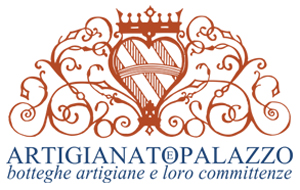Craft workshops
In Florence, as in Rome, it is still quite common to find in the streets of the historic centre, on the ground floors of ancient palaces, workshops where solitary engravers, framers, silversmiths, bronze workers, restorers, interior decorators, upholsterers, goldsmiths… work. In the small streets adjacent to Piazza de’ Pitti or Santa Croce, it is not uncommon to find old furniture lined up on the pavement, in front of the workshop, drying in the sun to finish the restoration work, while groups of hurried tourists walk around it to reach the most famous places in the city, planned in their short Florentine tour. It would be important, with a little more time on one’s hands, to also get to know a city’s handicrafts, the techniques used and the environments where they take place. These places often have a strong evocative power and at the same time great historical and cultural importance, due to their similarity to the images depicted in the tables of the Encyclopédie, the famous 18th-century repertory of Arts and Crafts. The craftsman’s workshop represents the place where, with traditional tools, the craft handed down over the centuries, everyday experience and contemporary culture, new and original products are made. In the workshop, and sometimes in the same person, the phases of conception, design and realisation of the product come together. This cultural heritage, which increasingly tends to have a strongly individual character, must be defended and supported in the laborious work of updating it. In the second half of the 20th century, the figurative renewal that involved all areas of the Arts, including the so-called Minor Arts, resulted in a clear break with the past; this led to the discontinuation of traditional work and the closure of old factories and workshops. However, in many Italian cities, and especially in Florence, the artistic past was not completely forgotten and above all, the tradition of workmanship and the culture of the craft was not abandoned. To the decline of imitation in style and the copying of the antique, knowledge and technical skills have survived. We can cite as an example the tradition of woodworking, for which Florence was famous in the 19th century; the great school of Frullini, Gaiani, Morini, Fanfani, Baccetti, Giusti, Coppedè, whose workshops produced furnishings that were defined as “masterpieces of the art of carving and inlaying in ancient and modern styles”, has left over time artisans, restorers and conservators, capable of restoring carvings, inlays, gilding, lacquering, according to the needs of a fairly lively market no longer tied only to the oldest centuries.
Daniela Mignani
Soprintendenza per i Beni Ambientali ed Architettonici per le province di Firenze, Pistoia e Prato
We have thus arrived at the 3rd edition of ARTIGIANATO E PALAZZO with the approval, support and trust of those true craftsmen who still resist and fight to save their identity and that quality and refinement that only they, with their manual work, can achieve.
All conservators of ancient objects and monuments know how valuable the intervention of a true craftsman is in the maintenance and restoration of works of art. Indeed, one must not believe that one can do without the atavistic taste, patience and passion that are the most important traits of a craftsman’s activity, which, through the generations, form the most extraordinary fabric of a civilisation based on centuries-old traditions that unfortunately great progress is destroying.
We must open our eyes before it is too late, and I therefore hope with this ‘little – big’ exhibition of ours to give support to this category that is so precious and irreplaceable and that does us the honour of being present in our garden again this year.
I would also like to thank the sponsors who have helped us so much again this year: Gucci, our long-standing official sponsor, the Cassa di Risparmio di Firenze, the auction house Christie’s, Charles Heidsieck champagne, and Tax Free who promoted the English and Japanese editions of this catalogue.
Giorgiana Corsini
For the 3rd edition of ARTIGIANATO E PALAZZO
With the first two editions of ARTIGIANATO E PALAZZO we brought together in Florence more than 120 of the most extraordinary and capable Italian artisans, involving more than 12,000 visitors from all over Italy during the few days of the exhibition. Breaking away from the traditional canons of other Exhibition-Markets, ARTIGIANATO E PALAZZO represented a cultural and informative contribution to the “minor arts”.
Starting from the idea that in handicrafts, creation never ends and each work is never the same as another, the exhibitors selected by us for ARTIGIANATO E PALAZZO are once again called upon to demonstrate live the various working techniques in which they excel, emphasising the strong social relevance of the craftsman and using the ‘Palazzo’ as a showcase and place for experimentation.
My due thanks this year go to Mariolina Dufour Berte who helped me so much, to Olivella Pianetti della Stufa and Valentina Grazzini, to Alessandro Grassi, Chiara Ponticelli and Elisa Baroni who took care of our Press Office, to surveyor Piero Corti, and to the ladies of the Administration, Cesarina Bigalli, Manola Chemeri, Fiorella Fanfani and Elmira Gorini who, together with Giuseppe, Maurizio and Romeo, followed us with kindness and patience.
Neri Torrigiani
The Cassa di Risparmio di Firenze Prize
Benvenuto Cellini’s Perseus lends its image and name to the Prize that the Cassa di Risparmio di Firenze awards to the ARTIGIANATO E PALAZZO exhibitor most appreciated by the public.
Cellini’s masterpiece, now under restoration thanks to the intervention of the Cassa di Risparmio di Firenze, is the symbol of that encounter between humanism and technical evolution that made the Florentine Renaissance one of the founding episodes of European culture and history. An encounter that had precisely in the ‘botteghe’ one of its essential places.
And it is to this great tradition of Florentine workshops that the award is intended to refer, offering recognition to those who know how to keep alive the interest in the artisan ‘workshop’, for a place, that is, where quality is at home and where the final product is the bearer of culture. An artisan culture that the Cassa di Risparmio di Firenze, thanks to its close ties with the territory, knows well and which, in its banking, it actively supports.
In the sign of Perseus, moreover, the Cassa di Risparmio di Firenze has set up an important communication campaign aimed at affirming the enduring vitality of the encounter between technology and humanism in its own banking activity. In its planning efforts, as in its daily operations, the Cassa has in fact as its primary objective the global quality of service as a result of the correct fusion of technology and human capabilities.
Aureliano Benedetti
Chairman of Cassa di Risparmio di Firenze S.p.A.
Christie’s presence at ARTIGIANATO E PALAZZO
Christie’s, founded in 1766 by James Christie in London, is today an important international company with over one hundred offices worldwide and auction rooms in Europe, the United States, the East and Australia. In Italy it has been present since 1958 in Rome, as its first foreign office, and is currently based in the splendid setting of Piazza Navona in Palazzo Massimo Lancellotti. A representative office is active in Milan, while a capillary network of regional agents offers the auction house’s services throughout Italy and abroad, free valuations, advice on storage and transport of art objects and others related to the art world.
Auctions in Italy include sales of Jewellery, Silver, Icons, Watches, Furniture and Art Objects, Old and 19th Century Paintings, Books, Autographs and Manuscripts in Rome, and Modern and Contemporary Art in Milan.
Christie’s also organises and promotes conferences, exhibitions of foreign auctions, special visits to museums and private collections. As part of the spring 1977 events, the auction house is pleased to participate in ARTIGIANATO E PALAZZO with a lecture by the head of Christie’s Italy’s Old Masters Department.
Professor Riccardo Lattuada
‘Aspects of artistic patronage in Baroque Italy’
Illustrated pictorial excursus on the relations of taste and cultural orientation between the aristocracy and Italian artists from 1650 to 1780
For further information please contact
Alessandra Niccolini di Camugliano
Christie’s representative for Tuscany
P.O. Box 62 – Ponsacco (Pi)
telephone and fax 0587/735487
Christie’s Milan
Piazza S. Maria delle Grazie, 1
telephone 02/4670141
fax 02/46701429
Christie’s Rome
Piazza Navona, 114
telephone 06/6872787
fax 06/6869902


